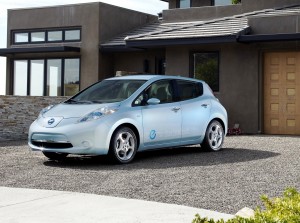Nissan North America, Inc. (NNA) today announced that the 2011 Nissan Leaf electric vehicle, starts at $32,780 MSRP before a $7,500 federal tax credit, plus taxes, title and license fees. A Leaf lease starts at $349 per month.
The pure electric vehicle needs a charging dock, which Nissan says will cost another $2,200 on average, and require eight hours to fully recharge Leaf’s 48 lithium ion battery modules.
There are also other potential subsidies for the small car – 175 inches in length – with what is claimed to be a 100-mile range. There is $5,000 statewide tax rebate in California; a $5,000 tax credit in Georgia; a $1,500 tax credit in Oregon; and carpool-lane access in some states, including California. The charging dock and installation are eligible for a 50% federal tax credit up to $2,000.
Leaf will be at Nissan dealers in select markets this December, and roll-out nationwide in 2011. Nissan will begin taking consumer reservations for the Nissan Leaf on April 20 for a refundable $99 fee.
Leaf is powered by laminated lithium-ion batteries, which provide a power output of more than 90 kW with 24 kW hours of capacity – roughly $24,000 worth of batteries at current prices. Its electric motor delivers 80 kW/280 Nm.
Nissan hopes this pricing will make its EVs more than the limited volume technical curiosities that EVs are today. However, the small car faces stiff competition from larger and technically advanced hybrid vehicles, such as Toyota Prius and Honda Insight, as well as simpler economy cars in the $10,000 to $17,000 range, including Nissan’s own Versa and Sentra models.
“Imagine the possibility of never needing to go to a gas station again, or of paying less than $3 for 100 miles behind the wheel, said Brian Carolin, senior vice president, Sales and Marketing, NNA.
The Leaf prices analyzed here are for the SV trim level model, which includes a navigation system and Internet/smart phone connectivity to the vehicle, enabling pre-heat/pre-cool and charging control. There are LED headlights, Bluetooth connectivity, Intelligent-key with push button start, Sirius/XM satellite radio capability and three years of roadside assistance.
More traditional automotive hardware (which also means software these days) includes stability control, traction control and six airbags. The SL trim level, available for an additional $940 (MSRP), adds a rearview monitor, solar panel spoiler, fog lights and automatic headlights. The electric motor is in essence a one-speed automatic transmission.
Nissan will offer personal charging docks, which operate on a 220-volt supply, as well as their installation by AeroVironment, as part of a one-stop-shop process that includes a home assessment.
Using current national electricity averages, of $0.116 / kWH, Nissan claims it will cost less than $3 to “fill up.” It looks like we are going to have to add a new disclaimer to replace the “your mileage may vary” with “your rates may vary.” In suburban Detroit the basic rate is .15 for example with politicians pondering a 20% increase.


Last month I had the privilege of driving the Leaf test mule at the London O2 venue. The sensation was positive with silky smooth acceleration that was plenty brisk and serenely quiet. Moving off in EV mode in a Prius is sedate compared to this which was more akin to full on acceleration without the engine noise.
The actual Leaf prototype which was on static display took my six-two frame with room to spare plus there was sufficient room in the rear and in the trunk. The battery pack was nowhere to be seen as its dispersed at various points under the floor. These are flat laminated modules resembling a laptop in size. There was nothing to be seen under the hood but a black plastic cover shielding the electric drive motor and electronics. If the drive selector of the mule is to be used on production models I would question the logic of its operation. Forward drive is selected by pulling it back and reverse by pushing it forward, it seems to be more logical for it to be the other way round. Another point is the recharge flap which if the car is sitting out side in a downpour while being charged looks a bit vulnerable. These two points aside I would certainly buy one for ninety nine percent of my driving needs and adopt new ways for further journeys i.e. public transport or rent something. I see this as a progression from my Prius both in efficiency and in altering my conception of what I really need for most of my transport throughout the year.